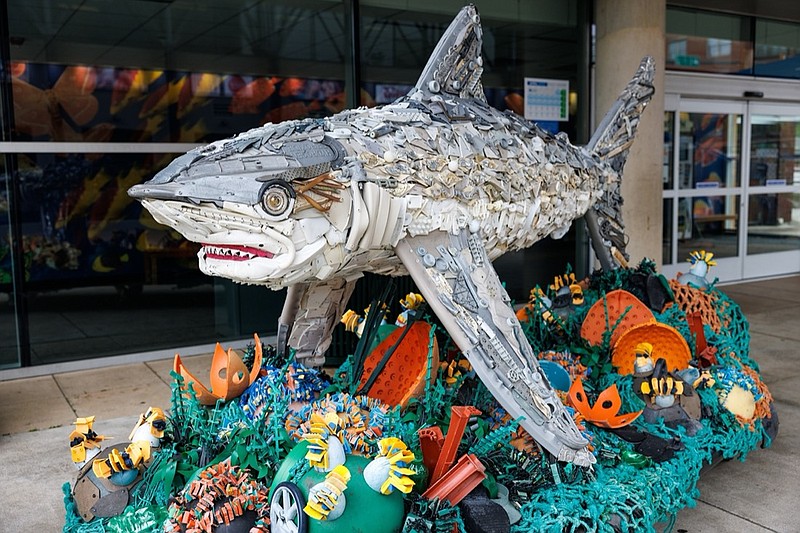At least 14 million tons of plastics end up in the ocean every year, according to the International Union for Conservation of Nature. Many of these items are things we use on a daily basis, from toothbrushes to takeout containers to food wrappers.
Even when we try to minimize our use of plastics, they're impossible to avoid entirely, and we rarely see the effects of the plastic waste we produce - effects such as sea turtles that get plastic straws stuck in their nasal cavities, or albatross chicks that never make it to adulthood because their parents fed them plastic they mistook for food.
Washed Ashore, an exhibit on display at the Tennessee Aquarium through Oct. 31 in honor of the attraction's 30th anniversary, seeks to bring attention to the issue of marine plastic pollution with massive, eye-catching sculptures of marine life composed of plastic debris collected from the ocean.
"It's sort of a mosaic of plastic," aquarium spokesman Thom Benson says of the sculptures. "With all of these pieces, I think it's really fun to stand back and watch other people reacting to it, because your first impression is, 'Wow, that's really neat.' And then you look close and go, 'Oh, there's a toothbrush or a comb or a bottle cap or a golf ball,' and you kind of spend time walking around the sculptures or looking at the different pieces and trying to identify all the parts."
One of the sculptures, "Fish Bite Fish," is made up entirely of plastic pieces with jagged edges, because sea turtles, crabs and fish had gnawed at the plastic thinking it was food.
"Our goal is to really bring awareness and initial emotional responses through our sculptures, to really then prompt behavior change to reduce the amount of plastic we have in our daily life that can end up in the ocean," says Brad Parks, conservation education director for the Oregon-based nonprofit organization, Washed Ashore, which is focused on conservation through art. "The aquarium really wanted to do something different and to highlight their role as a conservation organization as well as an amazing guest experience. To be here for the 30th anniversary is really to bring awareness now to the local community of this issue - it's also a river issue - but also to really help them celebrate this big milestone of 30 years."
Aside from the harm caused to marine life that attempt to consume whole pieces of plastic, animals - including humans - are also ingesting microplastics, which are plastics that have broken down into pieces 5 millimeter or smaller, about the size of a pencil-top eraser.
The Tennessee River is chock-full of microplastics, which make their way into waterways through methods such as stormwater runoff, fibers shed from synthetic clothing when it's washed and plastic litter that slowly breaks down into smaller pieces.
Aquarium staff created their own sculpture, a Southern brook trout they named "Trashy Trout," using local river trash.
In addition to Washed Ashore's animal sculptures, the exhibit also includes a series of pieces depicting human faces, titled "The Plastic Tribe."
"The messaging behind that is that we're all part of this problem, but we can also all be part of the solution," Benson says of the Picasso-esque faces whose features are composed of discarded plastic, such as mismatched eyes made from items like fishing floats and a nose fashioned from the handle of a bottle of bleach.
